About Authors:
Swathi.Pathi*, Swarna Latha.D, M.Sreenivasulu.
Department of Pharmaceutical Chemistry,
Annamcharya college of pharmacy, newboyana pally, rajampet(M),
kadapa(dt). Andhara Pradesh, India.
*swathi.janu3@gmail.com
1. INTRODUCTION
A heterocyclic compound is one which possesses a cyclic structure with at least two different kinds of hetero atoms in the ring. Heterocyclic compounds are very widely distributed in nature and are essential to life in various ways1.
The chemistry and biological study of heterocyclic compounds has been an interesting field for a long time in medicinal chemistry. A number of heterocyclic derivatives containing nitrogen and sulphur atom serve as a unique and versatile scaffolds for experimental drug design2.
Benzothiazole is one of the most important heterocyclic compound, weak base, having varied biological activities and still of great scientific interest now a days. They are widely found in bioorganic and medicinal chemistry with application in drug discovery.
Benzothiazole is a privileged bicyclic ring system. Due to its potent and significant biological activities it has great pharmaceutical importance; hence, synthesis of this compound is of considerable interest. The small and simple benzothiazole nucleus if present in compounds involved in research aimed at evaluating new products that possess interesting biological activities.
REFERENCE ID: PHARMATUTOR-ART-1635
Benzothiazolemoites are part of compounds showing numerous biological activities such as antimicrobial3-7, anticancer8-11, anthelmintic12, anti-diabetic13 activities etc, They have also found application in industry as anti-oxidants, vulcanisations accelerators. Various benzothiazoles such as 2-substituted benzothiazole received much attention due to unique structure and its uses as radioactive amyloidal imagining agents14, and anticancer agents15.
In the 1950s, a number of 2-aminobenzothiazoles were intensively studied, as the 2- amino benzothiazole scaffold is one of privileged structure in medicinal chemistry and reported cytotoxic on cancer cells16. It must be emphasized that combination of 2-aminobenzothiazoles with other heterocyclic is a well known approach to design new drug like molecules, which allows achieving new pharmacological profile, action, toxicity lowering.
Benzothiazoles are fused member rings, which contain the heterocycles bearing thiazole. Sulphur and nitrogen atoms constitute the core structure of thiazole and many pharmacologically and biologically active compounds. Thiazole is structurally related to thiophene and pyridine, but in most of its properties it resembles to the latter. Thiazole was first described by Hantzsch and Waber in 1887. Popp confirmed its structure in 1889. The numbering in thiazole starts from the sulphur atom. The basic structure of benzothiazole consist of benzene ring fused with 4, 5 position of thiazole.
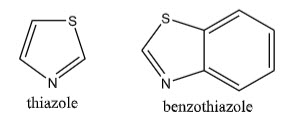
A brief account of some commonly used methods to synthesize as well as cyclization of benzothiazole derivatives by using different type catalysts and various structural alterations conducted on benzothiazole ring and preferential specificities imparted in their biological responses.
STRUCTURE:
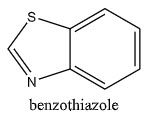
CHEMICAL AND PHYSICAL PROPERTIES :
Molecular formula : C 7 H 5 NS
Molecular weight : 135.19
Description 17 : yellow liquid with pleasant odour
Boiling point 18 : 231%c
Melting point 18 : 2%c
Solubility 18,19 : slightly in soluble in water,
very soluble in ethanol, diethyl ether,
And carbon disulphide,
Insoluble in acetone.
Refractive index 18 : 1.6379 at 20%c
Vapour pressure 20 : 0.07 mm Hg at 20%c
Reactivity 21 : reacts with aldehydes or ketones to
generate alpha hydroxyl carbonyl compounds
2. SYNTHESIS
Recently, several new methods have been reported, some of the most common methods for the synthesis of benzothiazole are as follows
I. By using acetic anhydride to synthesized 2-substituted Benzothiazole :
1. Benzothiazole may be prepared by action of acid anhydrides (or) chlorides on o-aminophenols and formic acid in presence of acetic anhydride22,23.

2. 2-mercaptobenzothiazole is vulkanisation accelerator it may be prepared as follows22,23.

II. By using Phosphorus pentasulfide to synthesized 2-substituted Benzothiazole :
Benzothiazoles are also formed by action of phosphorus pentasulfide on o-acylaminophenoles22,23.

III. By condensation of o-aminothiophenol to synthesized 2-substituted Benzothiazole :
O-aminothiophoenol is a versatile starting material for synthesis of different kind of heterocyclic rings. 2- Substituted Benzothiazole can easily synthesize by applying condensation with aldehydes and substituted aromatic acids in presence of different catalyst.
* Condensation of o-aminothiophenol with aldehydes 24:
Treatment of o-aminothiophenols with substituted aldehydes affords the synthesis of 2- substituted benzothiazoles using different catalysts and reaction conditions.
Catalysts (a-f):
a. Montmorillonite, SiO2/Graphite; Microwave, p-TsOH
b. Diethyl bromophosphonate/tert-Butyl hypochlorite, acetonitrile
c. Cerium (IV) ammonium nitrate
d. H2O2 /HCl system in ethanol
e. AcOH /Air, Microwave/ Thermal Heating
f. Baker’s yeast, Dichloro methane

* Condensation of o-aminothiophenol with acids 24:
Treatment of 2-aminothiophenol and substituted aromatic acids in presence of Polyphosphoric acid provides a good method to synthesize 2- substituted benzothiazoles and gives a good yield19.

IV. By cyclization to synthesized 2-substituted Benzothiazole 24
Thioformanilides using different catalysts :
Substituted thioformanilides can be converted to 2-aminobenzothiazoles via intramolecular C-S bond formation/C-H functionalization utilizing various reagents and catalysts.
Catalysts (a-e):
a. CuI; 1, 10-Phenanthroline, CS2CO3, reflux
b. Manganese triacetate
c. CS2CO3, Dioxane
d. Photochemical cyclization induced by chloranil
e. Pd (PPh3)4/MnO2 system under an oxygen atmosphere

V. By coupling synthesized to 2-substituted Benzothiazole24
Coupling between thiophenols and aromatic nitriles:
Thiophenols when treated with aromatic nitriles to affords a smooth reaction mediated by cericammonium nitrate to give corresponding 2- arylbenzothiazoles in excellent yield.

VI. By synthesis using substituted anilines to synthesized 2-substituted Benzothiazole24 :
Different substituted anilines when treated with KSCN in presence of glacial acetic acid to synthesize 2-substituted Benzothiazole

VII. By using of different type of catalysts to synthesized 2-substituted Benzothiazole24,25 :
(A) Bromine as catalyst
Recently several methods reported which utilize bromine as catalyst. Basically cyclization with bromine achieved by oxidation of aniline, substituted aniline and arylthiourea in acid or chloroform with alkali thiocyanate.
2-aminobenzothiazole and found that an arylthiourea can be cyclized with liquid bromine in chloroform to form a 2- aminobenzothiaozles

2-amino-5, 6-dichloro and 2- amino-6, 7- dichlorobenzothiazole by cyclization of suitable substituted aniline with help of thiocyanogen
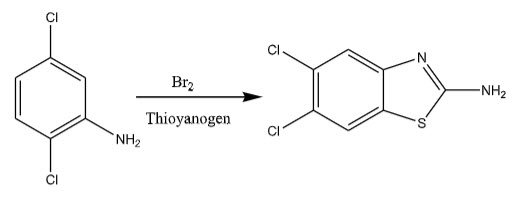
(B) Sulphuric acid as a catalyst
Allen used sodium thiocyanate and cyclize p-substituted aniline into 2-amino-6-substituted Benzothiazole in the presence of sulphuric acid which act as a catalyst.

(C) Benzene as a catalyst
cyclizations of isothiocyanates to 2- aminobenzothiazole in presence of benzene.

(E) Copper- and palladium-catalyzed cyclization
2-aminobenzoyhiazoles through analogous C-S bond forming methodologies. They formed the intramolecular C-S bond with the help of copper-and palladium-catalyzed. Copper- and palladium-catalyzed intramolecular C-S bond formation by cross-coupling between aryl halide and thioureas functionality is demonstrated for the synthesis of 2-aminobenzothiazoles.

(F) Bakers’ yeast to catalyze cyclization26
Employing bakers’ yeast to catalyze the condensation of 2- aminothiophenol and aldehydes in DCM to yield 2-substituted benzothiazoles in moderate to good yields under mild reaction condition.

(G) Manganese triacetate as a catalyst27
Manganese (III) triacetate is an excellent one-electron oxidant, which has been widely employed to generate free radicals for cyclization reactions. Manganese triacetate is introduced as a new reagent to replace potassium ferricyanide or bromine for radical cyclization of substituted thioformanilides. 2-Substituted benzothiazoles are generated in 6 min under microwave irradiation.

(K) Pyridine as catalyst28
The synthesis of 2-aryl benzothiazoles from gem-dibromomethylarenes using 2-aminoarylthiols with pyridine is obtained. Benzothiazoles were obtained in high chemical yields under mild conditions. This transformation would facilitate synthesis by short reaction times, large-scale synthesis, easy and quick isolation of the products, which are the main advantages of this procedure.

(L) PIFA as catalyst29
A new and general method has been developed for the intramolecular cyclization of thiobenzamides to benzothiazoles via aryl radical cations as reactive intermediates. The method utilizes phenyliodine (III) bis(trifluoroacetate) (PIFA) in trifluoroethanol or cerium ammonium nitrate (CAN) in aqueous acetonitrile at room temperature to effect cyclization within 30 min in moderate yields.

3. PHARMACOLOGICAL ACTIVITIES
In present review our main objective is to search for the potent compound for pharmacological activities with lesser adverse effects. Benzothiazoles are established in literature as important biological active heterocyclic compound.These derivatives are the subject of many researches studiesdue to their wide spread potential biological activities.
Literature survey revealed that benzothiazole derivatives posses diverse biological activities.
Various pharmacological activities are as follows :
1. Antileshmanial and anticistosomicidal activity
2. MTP inhibition activity
3. Amyloid imaging agent in alzheimers disease
4. Anti tubercular activity
5. Anti convulsant activity
6. Anti bacterial and anti fungal activity
7. Cyclogenase inhibitor activity
8. Anti helmenthic activity
9. Anti cancer activity
10. Anti diabetic activity
11. Anti inflammatory activity
12. Anti malarial activity
1.Antileshmanial and Antischistosomicidal activity30,31:
Acridone derivatives of benzothiazole were synthesized and evaluated for antileshmanial activity towards Leishmania promastigotes. Two derivatives, 4- (6- nitro- benzothiazol-2- ylamino)- 10H- acridin- 9- one (a) and 1-(6-amino-benzothiazol-2-ylamino)-10- H-acridine-9-one (b) revealed a selective antileishmanial activity. The prersence of a 6-amino benzothiazole group on position 2-amino chain and a 6-nitro benzothiazole group on position 4 amino chain was found essential for antiamastigote properties.
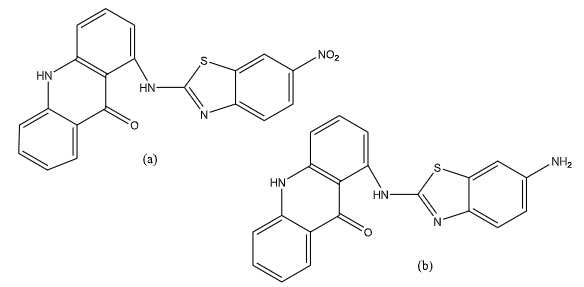
A series of benzothiazol-2-yl-dithiocarbamates and their copper complexes was prepared and evaluated for their in-vitro Schistosomicidal activity against Schistosoma mansoni. The copper complexes showed an activity similar to Praziquantel with 100% worm mortality at 10 μg/ml .
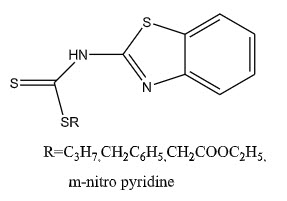
2. MTP Inhibition activity
Triamide derivatives based on benzothiazole templet. A series of these compounds showed potent enterocyte-specific microsomal triglyceride transfer protein (MTP) inhibitors. Inhabitation of MTP by small molecules, therefore lead to reduction in plasma triglycerides and cholesterol level.
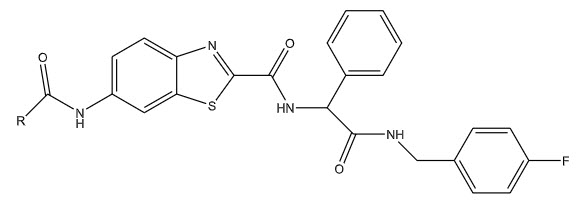
3. Amyloid imaging agent in Alzheimer’s disease33
F-labelled 2-(4′-fluorophenyl)-1-3- benzothiazoles. They Evaluated it as amyloidal imaging agent in Alzheimer’s disease in comparison with [11C]PIB (11C labelled 6-hydroxy-2-(4”-N- [11C] methyl aminophenol)-1,3-benzothiazole and showed excellent characteristics comparable with those of [11C]PIB, namely good affinity for amyloidal plaques present in human Alzheimer’s disease.

4.Anti-tubercular activity34
Some 4-Amino-N-(1,3- benzothiazol-2-yl) benzenesulphonamide derivatives were prepared and found to have good in-vitro Antimycobacterial activity (A) against H37Rv strain of mycobacterium tuberculosis and other derivatives (B) and (C) were also found active as antibacterial and antifungal agents 76.
|
|
R1 |
R2 |
|
A |
Cl |
COOH |
|
B |
Br |
OCH3 |
|
c |
Cl |
CH3 |
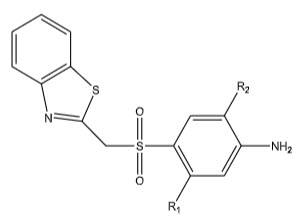
5.Anticonvulsant Activity35
For anticonvulsant activity, a large number of benzothiazole derivatives were evaluated and found to possess significant activity against various types of seizures. In search of potent anticonvulsants containing benzothiazole moiety, a series of N-(6-substituted-1, 3-benzothiazol-2-yl)-4- {[(subsituted amino) carbonothioyl] amino} benzene sulfonamides is active anticonvulsant in MES and PTZ induced seizures
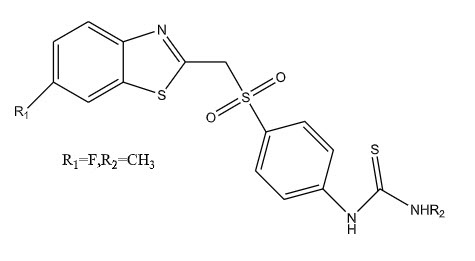
6.Antibacterial and antifungal activity37,38
Some 2- substituted benzothiazoles is examined against E. coli and S. aureus for antibacterial activity and Candida albicins and Aspergillus niger for antifungal activity. Most of the compounds showed promising results for both activitie
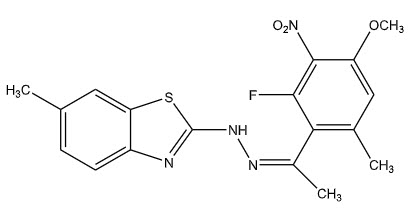
7.Cyclooxygenase inhibitor activity39
A series of 2-[(2- alkoxy-6-pentadecylphenyl) methyl] thio-1-Hbenzimidazoles/ benzothiazole from anacardic acid (pentadecyl salicylic acid) and investigated their ability to inhibit human cyclooxygenase enzyme-2.
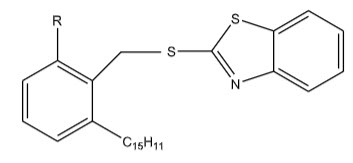
8.Anthelmentic activity40
Flurobenzothiazole comprising sulfonamide pyrazole derivitives. They screened synthesized for anthelmentic activity by using earthworms (Peritumaposthum). Albendazole was used as standard drug. The compounds were evaluated by time taken for complete paralysis and death of worms.

9.Anti-cancer activity41,42
Refluxed o-aminophenols with substituted benzoic acid in presence of polyphosphoric acid at higher temperature to get aryl substituted benzothiazoles and evaluated them against Human Cervical Cancer cell lines as anticancer drugs.
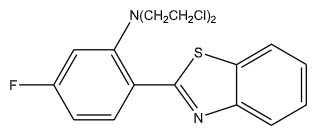
Benzothiazole containing phthalimide and studied their anti-cancer activity on human carcinoma cell lines.
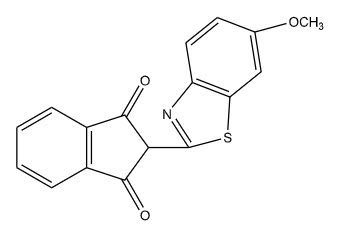
10.Anti-diabetic activity43
Synthesized 2-amino[5`(4- sulphonylbenzylidine)-2,4- thiazolidnedione]-7-chloro-6- flurobenzothiazole series and screened for their antidiabetic activity on albino rat by alloxan induced tail tipping method.
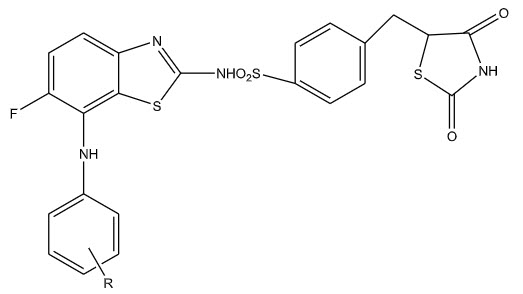
11.Anti-Inflammatory Activity44
In the recent years, a large number of benzothiazole based anti-inflammatory agents have been synthesized. Some novel 2-amino benzothiazole derivatives and evaluated them for anti-inflammatory activity. Test compounds showed significant anti-inflammatory activity and it was noted that when the 2-amino benzothiazole is substituted at 4 or 5 positions with electron withdrawing groups like Cl, NO2, OCH3 increase in anti-inflammatory activity was found.
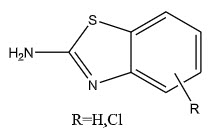
12.Antimalarial activity45
Antimalarial activity of 2- substituted-6- nitro and 6-amino benzothiazoles and their anthranilic acids were carried out on W2 and 3D7 strains of P. falciparum. The results revealed the potency of compounds as the antimalarial agents of clinical and biological research.
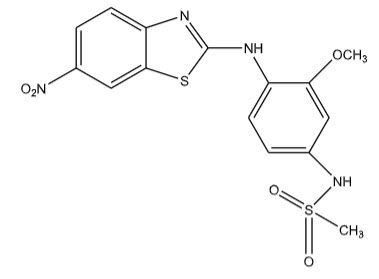
4.CONCLUSION
Benzothiazole derivatives are an important class of heterocyclic compounds. In recent years heterocyclic compounds analogues and derivatives have attracted strong interest due to their biological and pharmacological properties. The benzothiazole nucleus containing compounds involved in research aimed at evaluating new products that possess biological activities, such as antimicrobial, antifungal, anthelmintic, anti-diabetic, amyloidal imagining agents and anticancer agents.
The versatile synthetic applicability & biological activity of these heterocycle compound will help the medicinal chemists to plan, organize & implement new approaches towards discovery of novel derivatives of benzothiazole.
5. REFERENCES
1. Achson A. An. 3rd ed.,Willy-Intersciences, India, 2009.
2. Patel NB, Shaikh FM. Sci Pharm 2010; 78: 753-765.
3. Gupta S, Ajmera N, Gautam N, Sharma R, Gauatam D. I J Chem 2009; 48B: 853-858.
4. Kumbhare RM, Ingle VN. I J Chem 2009; 48B: 996-1000.
5. Murthi Y, Pathak D. J Pharm Res 2008; 7(3): 153-155.
6. Rajeeva B, Srinivasulu N, Shantakumar S. E-Journal of Chemistry 2009; 6(3): 775-779.
7. Maharan M, William S, Ramzy F, Sembel A. Molecules 2007; 12: 622-633.
8. Kini S, Swain S, Gandhi A. I J Pharm Sci 2007; Jan-Feb: 46-50.
9. Stanton HLK, Gambari.R, Chung HC, Johny COT, Filly C, Albert SCC. Bioorg Med Chem 2008; 16: 3626-3631.
10. Wang M, Gao M, Mock B, Miller K, Sledge G, Hutchins G, Zheng Q. Bioorg Med Chem 2006; (14): 8599-8607.
11. Hutchinson I, Chua MS, Browne HL, Trapani V, Bradshaw TD, Westwell AD. J Med Chem 2001; 44: 1446-1449.
12. Sreenivasa M, jaychand E, Shivakumar B, Jayrajkumar K, Vijaykumar J. Arch Pharm Sci and Res 2009; 1(2): 150-157.
13. Pattan S, Suresh C, Pujar V, Reddy V, Rasal V, Koti B. I J Chem 2005; 44B: 2404-2408.
14. Reddy P, Lin Y, Chang H. Arcivoc 2007; xvi: 113-122.
15. Heo Y, Song Y, Kim B, Heo J. Tetrahedron Letters 2006; 47: 3091-3094.
16. Piscitelli F, Ballatore C, Smith A. Bioorg Med Chem Lett 2010; 20: 644-648.
17. Lewis, R.J., ed. (1993) Hawley's Condensed Chemical Dictionary, 12th ed., NY, Van Nostrand Reinhold, Co., p. 132Benzothiazole 95-16-9
18. Lide, D.R., ed. (1996) CRC Handbook of Chemistry and Physics, 76th ed., Boca Raton, FL, CRC Press, p. 3-80
19. Budavari, S., ed. (1996) The Merck Index, 12th ed., Whitehouse Station, NJ, Merck & Co., Inc., p. 186
20. Fisher Scientific (1997) Material Safety Data Sheet: Benzothiazole, Pittsburgh, PA
21. Aldrich Chemical Co., Inc. (1996) Aldrich Catalog/Handbook of Fine Chemicals, Milwaukee, WI, p. 146
22. Shivaraj H, Gazi S, Patil S, Surwas S. Asian J Research Chem 2010; 3(2): 421-427.
23. Yadav PS, Devprakash, GP Senthilkumar. Int J Pharm Sci and Drug Res 2011; 3(1): 01-07.
24. Khokra Sukhbir L, Arora Kanika, Mehta Heena, Aggarwal Ajay, Yadav Manish. Int J Pharm Sci and Res 2011; 2(6): 1356-1377.
25. Gupta Akhilesh, Rawat Swati. J Curr Pharm Res 2010; 3(1): 13-23.
26. Umesh RP, Jyotirling RM, Dhanaji VJ, Ramrao AM. J. Tetrahedron Letters 2009; 50: 1352-1354.
27. Mu Xue-Jun, Zou Jian-Ping, Zeng Run-Sheng, Wu Jun-Chen. Tetrahedron Letters 2005; 46: 4345–4347
28. Siddappa Chandrappa, Kambappa Vinaya, Umashankara Muddegowda, Rangappa Kanchugarakoppal S. Tetrahedron Letters 2011; 52: 5474–5477.
29. Downer-Riley Nadale K, Jackson Yvette A. Tetrahedron 2008; 64: 7741–7744.
30. Delmas F, Avellaneda A, Giorgio C, Robin M, Clercq E, David P and Galy JP: Synthesis and antileishmanial activity of (1,3-benzothiazol-2-yl)amino-9-(10H)-acridinone derivatives. European Journal of Medicinal Chemistry 2004, 39: 685-690.
31. Maharan M, William S, Ramzy F and Sembel A: Synthesis and in vitro evaluation of new benzothiazole derivatives as Schistosomicidal agents. Molecules, 2007, 12: 622-623.
32. Chi B, Jill C, David P, Song J, Choy W, Lambert P, Gagne D. Discovery of benzothiazole derivatives as efficatious and enterocyte-specific MTP inhibitors. Bioorg Med Chem Lett. 2009; 19:1416-20.
33. Serdons K, Verduyckt T, Vanderghinste D, Cleynhens J, Borghgraef P, Vermaelen P. Synthesis of 18F-labeled 2-(4′- fluorophenyl)-1-3-benzole and evaluation as amuloid imaging agent in comparison with [11C]PBI. Bioorg Med Chem Lett. 2009(17):602-605.
34. Bhusari KP, Amnerkar Nd, Khedekar PB, Kale MK and Bhole RP: Synthesis and in vitro antimicrobial activity of some new 4-amino-N-(1,3-Benzothiazol-2-yl) benzenesulphonamide derivatives. Asian J. Research Chem. 2008, 1(2): 53-58.
35. Siddiqui N, Pandeya SN, Khan S, Stables J, Rana A, Alam M, Arshad M and Bhat M: Synthesis and anticonvulsant activity of sulfonamide derivatives-hydrophobic domain. Bioorganic & Medicinal Chemistry Letters 2007, 17: 255-259.
36. Amnerkar N and Bhusari KP: Synthesis, anticonvulsant activity and 3D-QSAR study of some prop-2-eneamido and 1-acetyl-pyrazolin derivatives of aminobenzothiazole. European Journal of Medicinal Chemistry 2010, 45: 149-159.
37. Alang G, Kaur R, Singh A, Budhlakoti P, Singh A and Sanwal R: Synthesis, Characterization and antifungal activity of certain (E)-1-(1-(substitutedphenyl) ethylidene)-2-(6-methylbenzo[d]thiazol-2-yl) hydrazine analogues. International Journal of Pharmaceutical & Biological Archives 2010, 1(1): 56-61.
38. Suresh SH, Venkateshwara RJ, Jayaveera KN: Synthesis of 4-(2’-substituted benzothiaozles)-5-mercapto-3-(substituted)-1,2,4-triazole derivatives for possible antimicrobiological activities. Research Journal of Pharmaceutical, Biological and Chemical Sciences 2010, 1(4): 635-640.
39. Paramashivappa R, Phanikumar P, Subbarao P, Srinivasarao A. Design synthesis and biological evaluation of benzimidazole/benzothiazole and benzoxazole derivatives as cyclooxygenase inhibitors. Bioorg Med Chem Lett. 2003; 13:657- 60
40. Sreenivasa M, jaychand E, Shivakumar B, Jayrajkumar K, Vijaykumar J. Synthesis of bioactive molecule flurobenzothiazole comprising potent heterocylic moieties for anthelmintic activity.Arch Pharm Sci and Res. 2009; 1(2):150-157
41. Kini S, Swain S, Gandhi A. Synthesis and Evaluation of novel Benzothiazole Derivates against Human Cervical Cancer cell lines. Ind J Pharm Sci. 2007; Jan-Feb: 46-50.
42. Stanton HLK, R Gambari, Chung HC, Johny COT, Filly C, Albert SCC. Synthesis and anti-cancer activity of benzothiazole containing phthalimide on human carcinoma cell lines. Bioorg Med Chem. 2008; 16:3626-3631.
43. Pattan S, Suresh C, Pujar V, Reddy V, Rasal V, Koti B. Synthesis and antidiabetic activity of 2-amino[5”(4-sulphonylbenzylidine)-2, 4-thiazolidinenone]-7-chloro-6-flurobenzothiazole. Ind J Chem. 2005; 44B:2404-2408.
44. Venkatesh P and Pandeya SN: Synthesis, characterization and anti-inflammatory activity of some 2-amino benzothiazole derivatives. International Journal of ChemTech research 2009, 1(4): 1354-1358
45. Hout S, Azas N, Darque A, Robin M, Giorgio C, Gasquet M, Galy J and David P: Activity of benzothiazoles and chemical derivatives on Plasmodium falciparum. Parasitology 2004, 129: 525-542.
NOW YOU CAN ALSO PUBLISH YOUR ARTICLE ONLINE.
SUBMIT YOUR ARTICLE/PROJECT AT articles@pharmatutor.org
Subscribe to Pharmatutor Alerts by Email
FIND OUT MORE ARTICLES AT OUR DATABASE











